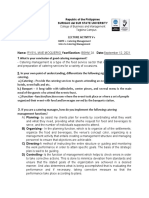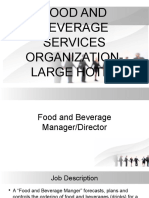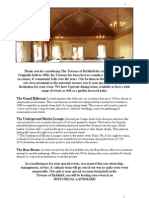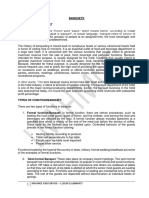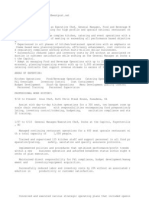Basic Menu Planning by G.solomon Saravanakumar
Basic Menu Planning by G.solomon Saravanakumar
Uploaded by
solomongsskCopyright:
Available Formats
Basic Menu Planning by G.solomon Saravanakumar
Basic Menu Planning by G.solomon Saravanakumar
Uploaded by
solomongsskOriginal Title
Copyright
Available Formats
Share this document
Did you find this document useful?
Is this content inappropriate?
Copyright:
Available Formats
Basic Menu Planning by G.solomon Saravanakumar
Basic Menu Planning by G.solomon Saravanakumar
Uploaded by
solomongsskCopyright:
Available Formats
Basic menu planning CHAPTER- 06
Menu planning
Menu is a French word which means a list of articles offered for sale which may
also be called programme of a meal or silent salesman. Its objective is to present a
list of dishes or courses, eatable and beverages.
One of the most important object of organization and planning is food service
industry is menu planning compiling of menu is an art and it needs careful selection
of dishes for different courses best results are obtained if the person incharge of the
food product plan the menu in consultation with the chef.
Menu planning is the time consuming but very important finished product
must fulfill the need of the test and give the people what they want, when they want.
Factors that influence menu planning/Principles of menu planning :
1 Location of the establishment:
If the establishment is situated in a business area the menu should be planned in a
certain way so the service would be quick and should be moderately priced.
Situated on highway/motels or road sides menu will after a ltd. Choice, quick service
and moderately priced. Residential area- menu should be moderately priced it
should appeal to families.
Food service
2 Type of establishment: If it is Chinese restaurant- majority of selection will be
Chinese. Snack bar – Majority of dishes will be snacks.
Menu pattern will vary from hotels, restaurants, hostel, hospitals and industrial
canteens. In a hostel or hospital and industrial canteen more or less fixed menu is
offered and important is given to nutritive value.
3 Type of customer: Type of people there age group, sex, religion, occupation
spending power should be taken into consideration a seating habits vary with group.
People doing physical and laborious jobs req. more substantial meal then people
who do clerical work.
4 Seasonal availability: Although in these days of cold storage ingredients of all are
available yet food in season should be included in the menu.
5 Availability of equipments in the kitchen: Menu should be in accordance to the
equipments in the kitchen to plan a menu for 3004 roast items with only oven, in the
kitchen would make it difficult for service.
6 Capability of kitchen and services staff : Do not plan an elaborate menu if it is the
beyond the ability of the cooks pre pack the dishes also consider the staff is capable
of serving certain dishes with special presentation.
7 Leftovers in hand: It is better to use leftovers and recover some money or cost
rather than spoiling the food. Chefs skill is in converting leftover to a new dish so
that customer does not know about it ( Specialty of the day )
8 Cost of the menu : The selling price of the menu should be kept in mind so that
the food cost is well controlled.
9. Policy of the establishment: Certain establishments may not serve exception foods
because of their policy eg, pork , beef.
10. Service hours : Also determines the type of menu.
Compiled by: Chef Reetu Uday Kugaji. 1
11. Nutritional factor : Menu should be nutritionally balanced.
12. Occasion : What kind of Occasion it is ???
For eg. Festivals, Marriages Etc.
Gastronomical rules
1. To avoid repetition each dish should be different in composition.
2. Composition of individual dishes must be excellent. This should be well
cooked , tastefully dressed .
3. Mode of cooking should be different so that each one is distinct from the
other bearing no relation in appearance of the all dishes .
4. Various types of sauces in the preparation and as accompaniment used must
be distinctly different in color taste and flavor.
5. When 2 or more types of fish are to be served first should be boiled or
poached and the 2nd fried or grilled or broiled.
6. The entrée should always be classified so that light dishes such as quick
croquette are served first and meat cutlets steaks are served later.
7. Too dark meat or too white meat must not follow each other.
8. If there are two soups one should be clear and other cream.
Don’t’s of menu ? (Writing )
a) Never write the word ‘ Gravy ‘ on the menu.
Roast Chicken – Roast Gravy.
b) Add sauce which is served apart after the main dish.
For eg : Fish Orly – Tomato Sauce.
c) Add accompaniment which is served separate after the main dish.
For eg : Yorkshire pudding – cheese straws.
d) Do not translate literally.
For eg : Chasseur means Hunters Style or Pomme bonne femme means good
lady
e) Do not translate words which are very common.
For eg: Mayonnaise , Hollandaise.
f) Do not add fancy name.
For eg : Grilled Mackrel a la meuniere.
Compiled by: Chef Reetu Uday Kugaji. 2
g) Do not write soup and roll.
h) Avoid over descriptive words.
i) Parsley is not put on the menu except they are the part of the dish.
For eg : Parsley butter.
Do’s of Menu.
a) When writing the menu it is very imp. to see that words are properly
spelt.
b) Sequences of the courses are maintained.
1) Name the article – Pomfret , Lamb.
2) Add the place of origin – Bombay Pomfret.
3) Name the part used – Fillet of Bombay Pomfret. Or Leg of Peshawari
Lamb or Roast leg of lamb.
4) Name the method of cooking – Roast leg of Peshawari Lamb.
5) Add the garnish. Roast leg of lamb with peas.
6) Finally add the sauce wherever necessary.
7) Alternations are allowed sometimes. Sometimes cheese may served before
sweet. First comes name of dish followed by garnish separately or a sauce.
Vegetables and the potatoes.
For eg : Poulet sauté Champignons, .Haricot verte, Pomme de terre anna
,Salade russe.
Kinds of menu
It must be clearly under stood that there are several kinds of menus:
1 Table d’hote –a set menu forming a complete meal at a set price. A choice
Of dishes may be offered at all courses; the choice and number of courses
Will usually be limited to two, three or four.
2 A la carte –a menu with all the dishes individually priced . The customers
can therefore compile their own menu. A true a la carte dish should be
cooked to order and the customer should be prepared to wait for this
service.
3 Special party or function menu -- are for banquets or functions of all kinds.
Compiled by: Chef Reetu Uday Kugaji. 3
As all the guests start the meal at the same time it is generally unsuitable to
Place items such as steak or souffle’ on the menu for large numbers. Care
Need to be taken with seasonable foods to ensure they will be available if
The menu is printed well in advance thus avoiding difficulty & embarrassment.
4 Ethic or specialty menus -- can be table d’ hote or a la carte specializing in
the food (or religion) of the country or in a specialized food it self .For
example, ethnic : Chinese , Indian , kosher , Afro-Caribbean , Greek , etc;
specialty: steak , fish, pasta , vegetarian , pancakes , etc. The kitchen staff
must now how to obtain and use the ingredients ,and important in this
respect is the ambience of the restaurant reflecting the menu.
5 Hospitals menu – usually take the form of the menu card given to the patient
the day before the service so that his or her preferences can be ticked. Both
National Health Service and Private hospitals cater for vegeterians and also
for religious requirements .In many cases dietitian is involved with menu
compilation to ensure nothing is given to the patients that would be
detrimental to their health. Usually hospital menu are of three to four courses.
6 Menus for people at work -- these are menus which are served to people at
Their place of work. Such menus vary in standard and extent from one
Employer to another due to company policy on the welfare of their staff and
Work force .Progressive companies ensure that their employees are well
Offer meals at a subsidized rate A number of staff restaurant s charge a price
That covers all the cost of food and labor with all other charges being.
Subsidized. In most of these places, whether or not it is a factory canteen or
Head office staff restaurant, the menu often offers atleast two or three
Course meal with the selection of items – a table d’ hote style menu . There may
Also may be call-order a la carte selection charged at higher price . The food
Will usually be mainly British with some ethnic dishes and a vegetarian dish .
The menu consist of soup , main meat and/or dish with vegetables ,
Followed by sweets ,cheese and yogurts . According to the policy of the
Management and employment requirements ,there will very often be a salad
Bar and healthy eating dishes included on the menu. When there is a captive
Clientele who face the same surroundings daily and meet the same people,
Then no matter how long the menu cycle or how pleasant the people ,or how
nice the decor ,boredom is bound to set in and staff then long for change
of scene. So, a chef or manager needs to vary the menu constantly to
encourage customers to patronize the establishment rather than going off
the premises to eat. The décor and layout of the staff restaurant plays a very
important part in satisfying the customer’s needs. The facilities should be
relaxing and comfortable so that he or she feels that the restaurant is not a
continuation of a work-place. Employees who are happy , well nourished
and now that the company has their interests and welfare at heart will tend
to be well-motivated and work better .
7 Menus for children – in schools there is an emphasis on healthy eating and a
Balanced diet in boarding schools . Those areas with children of various
Cultural and religious backgrounds have appropriate items available on the
Menu. Many establishments provide special children’s menus which
Compiled by: Chef Reetu Uday Kugaji. 4
Concentrate on favorite foods and offer suitably sized portions.
Cyclical menus
These are menus which are compiled to cover a given period of time ,ie one
Month ,three months, etc. They consist of a number of set menus for a
Particular establishment, eg industrial catering restaurant , cafeteria , canteen,
Directors dinning-room, hospitals or college or factory . At the end of each period
the menus can be used again thus overcoming the need to keep compiling new
ones . The length of the cycle is determined by management policy, by the time
of the year and by different foods available. These menus must be monitored
carefully to take account of changes in customer requirements and any
variations in weather conditions which are likely to affect demand for certain
dishes . If cyclical menus are designed to remain in operation for long periods
of time , Then they must be carefully compiled so that they do not have to be
changed too drastically during operation
Advantages of cyclical menus
1 They save time by removing the daily or weekly task of compiling menus ,
Although they may require slight alterations for the next period .
2 When used in association with cook /freeze operations ,it is possible to
Produce the entire number of portions of each item to last the whole cycle,
Having determined that the standardized recipes are correct .
3 They give greater efficiency in time and labor.
4 They can cut down on the number of commodities held in stock, and can
Assist in planning storage requirements.
Disadvantages of cyclical menus
1 When used in establishments with a captive clientele, then the cycle has to
Be long enough so that customers do not get bored with the repetition of
dishes.
2 The caterer cannot easily take advantage of good buys offered by suppliers
On a daily or weekly basis unless such items are required for the cyclical
menu.
Pre –planed and Pre-designed menus
Advantages
1 Pre-planned or Pre-designed menus enable the caterer to ensure that good
Menu planning is practiced.
2 Before selecting dishes that he or she prefers, the caterer should consider
What the customer likes, and the effect of these dishes upon the meal as a
Whole.
3 Menus which are planned and priced in advance allow banqueting
managers to quote prices instantly to a customer .
4 Menus can be planned taking into account the availability of kitchen and
Service equipment, without placing unnecessary strain upon such
equipment.
5 The quality of food is likely to be higher if kitchen staff are preparing dishes
that they are familiar with and have prepared a number of times before.
Compiled by: Chef Reetu Uday Kugaji. 5
Disadvantages
1 Pre-planned and pre-designed menus may be too limited to appeal to a wide
range of customers.
2 They may reduce job satisfaction or staff who have to prepare the same
menus respectively.
3 They may limit the chef’s creativity and originality.
Nature of the Menu’s
01.Length – there is no relationship between the length and quality of a menu.
If the menu is too short the customer may be disappointed at having
Insufficient choice ; if the menu is too long it may consist of a large number
Of dishes of mediocre quality . In general, it is better to offer fewer dishes of a
Good standard and aim to give customer what he or she wants (always
Remembering it is the customer who pays the bill)
02.Design- the design of printed menu should complement the image,
Atmosphere and décor of the restaurant or dinning room .The management
Policy on the frequency of menu change determines the design, and can give
The appearance of daily change. It must be remembered that design should
Not dominate practically. A poor design, however, can be detrimental to
The product and the image of the establishment.
03. Language- traditional menus use French, and in some cases French with an
English translation, but it is unwise to use a mixture of French and English .
It is important to when describing dishes to be accurate so that the customer
can identify the dish . Over-elaboration should be avoided as it may cause
disappointment . If we believe that menus are means of communication then
We should use the language which is easily understood, that is, English. As
The majority of customers are English – speaking then it seems logical that
Caterers Should be encouraged to use the national language. As an example,
‘ Poulet sauté chasseur or Sautéed chicken Hunter style is less informative to
The customers than ‘Chicken pieces fried and served in a white wine,
Mushroom, tomato and tarragon flavored sauce’.
04. Presentation- the way the menu is presented to the customer will often
Determine initial reaction to it – whether it is on the wall before entering
a staff dining room, handed to a patient in a hospital bed or presented by a
waiter or waitress. An off-hand, brusque presentation (either written or oral)
can be off-putting and can lower expectations of the meal.
**************************************************************
Compiled by: Chef Reetu Uday Kugaji. 6
You might also like
- When Planning The Food and Beverage For Any EventDocument3 pagesWhen Planning The Food and Beverage For Any EventKïtëł GägüïNo ratings yet
- Menu PricingDocument18 pagesMenu PricingtreeknoxNo ratings yet
- Catering Operations, Costs and Menu PlanningDocument14 pagesCatering Operations, Costs and Menu Planningkarupukamal100% (1)
- Assignment 1Document3 pagesAssignment 1Ansuman SahooNo ratings yet
- Persuasive Speech OutlineDocument6 pagesPersuasive Speech OutlinePatrick PastorNo ratings yet
- Chapter 3 Understanding and Applying Emerging Theories of Career DevelopmentDocument44 pagesChapter 3 Understanding and Applying Emerging Theories of Career DevelopmentJovena LimNo ratings yet
- Types of MenuDocument3 pagesTypes of MenuDebil100% (1)
- Menu PlanningDocument10 pagesMenu PlanningGeline Suzane Combalicer TobiasNo ratings yet
- Unit 1 MenuDocument13 pagesUnit 1 Menuram poudelNo ratings yet
- COST CONTROL FOOD PRODUCTION CONTROL ModuleDocument11 pagesCOST CONTROL FOOD PRODUCTION CONTROL ModuleAndy Porcalla Aguanta100% (1)
- Captain WaiterDocument10 pagesCaptain Waiterrose zandrea demasisNo ratings yet
- Opening A RestaurantDocument5 pagesOpening A Restaurantimranpathan30No ratings yet
- Syllabus CessDocument8 pagesSyllabus CessPrincessVeluzOrpilla67% (3)
- HMPE1 (Catering MGT.)Document17 pagesHMPE1 (Catering MGT.)Rysyl Mae MoquerioNo ratings yet
- Banquet vs. CateringDocument22 pagesBanquet vs. Cateringnadlornairb24100% (10)
- CateringDocument48 pagesCateringjomz100% (1)
- Hierarchy Area of Department & KitchenDocument5 pagesHierarchy Area of Department & KitchenChef Umesh JugranNo ratings yet
- Food and Beverage Staff OrganisationDocument6 pagesFood and Beverage Staff OrganisationTrill MateNo ratings yet
- Philtech Institute of Arts and Technology Inc. Subject: Banquet Sales Operation Week 4Document4 pagesPhiltech Institute of Arts and Technology Inc. Subject: Banquet Sales Operation Week 4Melissa Formento LustadoNo ratings yet
- 2.2 Function Catering PDFDocument10 pages2.2 Function Catering PDFSandilyan Ramanujam PagaldivitiNo ratings yet
- Food and Beverage Service SpielDocument4 pagesFood and Beverage Service SpielRechelle VillartaNo ratings yet
- Planning & Operating Various FNB OutletsDocument22 pagesPlanning & Operating Various FNB OutletsARUN JOSENo ratings yet
- Food and Beverage Services OrganizationDocument122 pagesFood and Beverage Services OrganizationMarife FranciscoNo ratings yet
- 7 Different Types of Catering Services You NeedDocument17 pages7 Different Types of Catering Services You NeedEstela SaludNo ratings yet
- 10.04 Kitchen Hygiene Manual Section 1,2,3 60pDocument5 pages10.04 Kitchen Hygiene Manual Section 1,2,3 60porientalhospitalityNo ratings yet
- Methods of Food ServiceDocument6 pagesMethods of Food ServiceAlok Rai0% (1)
- Restaurant Operations ManagementDocument21 pagesRestaurant Operations Managementharry4sum50% (2)
- 3NDocument4 pages3NKristine Rey Yap CabiliNo ratings yet
- Chapter 29 Food Cost ControlDocument11 pagesChapter 29 Food Cost Controloutmane4No ratings yet
- Banquet MenuDocument21 pagesBanquet MenureceptionhallsNo ratings yet
- CHAPTER 7 - The MenuDocument31 pagesCHAPTER 7 - The MenuSharif AfiqNo ratings yet
- 1 How To Serve A Bottle of Red WineDocument22 pages1 How To Serve A Bottle of Red WinemackybhoyamoresNo ratings yet
- Food Safety Notes 2nd YearDocument75 pagesFood Safety Notes 2nd YearnaubalkaushikNo ratings yet
- Trends in Food and Beverage OperationsDocument23 pagesTrends in Food and Beverage OperationsPatrick StarrNo ratings yet
- Types of Catering Establishments PRINTDocument3 pagesTypes of Catering Establishments PRINTSrinibas Jena100% (2)
- Module On Banquet and CateringDocument169 pagesModule On Banquet and Cateringbarabas skyNo ratings yet
- French Classical MenuDocument31 pagesFrench Classical MenuponavnitNo ratings yet
- Updated - Recipe CostingDocument23 pagesUpdated - Recipe CostingAnonymous BtgvmcNo ratings yet
- 08 Duties and Responsibilities of The Kitchen Brigade Are As FollowsDocument1 page08 Duties and Responsibilities of The Kitchen Brigade Are As FollowsChristine AfonsoNo ratings yet
- Banquet Functions and Catering ServicesDocument164 pagesBanquet Functions and Catering ServicesKhan Mohammad Mahmud HasanNo ratings yet
- Classification of Fs System 1Document26 pagesClassification of Fs System 1Prasanna SpideyNo ratings yet
- Development of Food & Beverage OperationsDocument28 pagesDevelopment of Food & Beverage OperationsKahyi TainNo ratings yet
- Chapter 4 Food Purchasing ControlDocument27 pagesChapter 4 Food Purchasing ControlshuhadaNo ratings yet
- Kitchen EssentialsDocument10 pagesKitchen EssentialsHannah Erlina100% (1)
- Banquet and Catering Services ProcedureDocument12 pagesBanquet and Catering Services ProcedureJulius de la CruzNo ratings yet
- Banquets Definition of BanquetDocument17 pagesBanquets Definition of BanquetARUN JOSENo ratings yet
- Basics of Catering ManagementDocument134 pagesBasics of Catering ManagementMohammad Abd Alrahim ShaarNo ratings yet
- Chapter 3b F & BDocument20 pagesChapter 3b F & BstarNo ratings yet
- Menu Planning AkpDocument4 pagesMenu Planning AkpAmit Mondal100% (1)
- Front Office MarketingDocument9 pagesFront Office MarketingRiya Yadav100% (2)
- Menu PlanningDocument23 pagesMenu PlanningChrison Moog MasangkayNo ratings yet
- Catering Company Business PlanDocument20 pagesCatering Company Business Plansatkartar100% (1)
- Catering Menu ProgramDocument51 pagesCatering Menu ProgramLi An BautistaNo ratings yet
- Restaurant Manager or Kitchen Manager or ChefDocument2 pagesRestaurant Manager or Kitchen Manager or Chefapi-78535324No ratings yet
- Restaurant Manager - Job Description PDFDocument1 pageRestaurant Manager - Job Description PDFHamid ChadharNo ratings yet
- ZAMORA, Christine Tiara T.: Food Service IndustryDocument6 pagesZAMORA, Christine Tiara T.: Food Service IndustryBiZayangAmaZonaNo ratings yet
- Powerpointg 7Document58 pagesPowerpointg 7Hennie BonillaNo ratings yet
- TM Select Catering Systems FN 030214Document68 pagesTM Select Catering Systems FN 030214Richard Zaw100% (2)
- Sea and Sky College City of San Fernando, La UnionDocument3 pagesSea and Sky College City of San Fernando, La UnionMONETTE P. COLOMANo ratings yet
- 6th Sem Notes Final PDFDocument95 pages6th Sem Notes Final PDFsarahmalex8No ratings yet
- Restaurant OSHA Safety and Security: The Book of Restaurant Industry Standards & Best PracticesFrom EverandRestaurant OSHA Safety and Security: The Book of Restaurant Industry Standards & Best PracticesNo ratings yet
- The Food Service Professionals Guide To: Building Restaurant Profits: How to Ensure Maximum ResultsFrom EverandThe Food Service Professionals Guide To: Building Restaurant Profits: How to Ensure Maximum ResultsNo ratings yet
- Gastric CancerDocument7 pagesGastric CancerMicah PingawanNo ratings yet
- 8 Hydrograph AnalysisDocument26 pages8 Hydrograph AnalysisMiera SaidNo ratings yet
- Facultad de Ingeniería Arquitectura Y Urbanismo Escuela de Ingeniería Civil AsignaituraDocument4 pagesFacultad de Ingeniería Arquitectura Y Urbanismo Escuela de Ingeniería Civil AsignaituraOswert rivera rojasNo ratings yet
- Tele-Neuropsychological Assessment Using Video-ConferencingDocument33 pagesTele-Neuropsychological Assessment Using Video-Conferencingrichard LemieuxNo ratings yet
- Certainty Antimicrobial Technology Fact SheetDocument2 pagesCertainty Antimicrobial Technology Fact SheetMauro Rojas ZúñigaNo ratings yet
- Staircase WiringDocument7 pagesStaircase WiringPersonal AccountNo ratings yet
- Chapter 7 Security in The Contemporary WorldDocument6 pagesChapter 7 Security in The Contemporary WorldDisha KhubchandaniNo ratings yet
- Assessment Nursing Diagnosis Planning Intervention Rationale EvaluationDocument7 pagesAssessment Nursing Diagnosis Planning Intervention Rationale EvaluationpamelaideaNo ratings yet
- Principles of Strength Training and ConditioningDocument7 pagesPrinciples of Strength Training and ConditioningAliciaNo ratings yet
- 1.CT8-04 Installation Manual enDocument90 pages1.CT8-04 Installation Manual enMansar100% (1)
- Session 3-1: Financial Literacy and Household Behavior Implications For Asia by Joanne YoongDocument20 pagesSession 3-1: Financial Literacy and Household Behavior Implications For Asia by Joanne YoongADBI Events100% (2)
- Soil Water PropertiesDocument55 pagesSoil Water PropertiesCt Kamariah Md SaatNo ratings yet
- Assignment On Basic Electricity and DC CircuitsDocument7 pagesAssignment On Basic Electricity and DC CircuitsIsabel Anicoche- VictorinoNo ratings yet
- Ontario Immunization Schedule ENDocument1 pageOntario Immunization Schedule ENRadijska Postaja KoprivnicaNo ratings yet
- BPO Powder CatalystDocument9 pagesBPO Powder Catalystdasrh 12No ratings yet
- Basic Design ReportDocument66 pagesBasic Design ReportmuhidNo ratings yet
- Tibetan CalendarDocument25 pagesTibetan CalendarChoten Duba100% (1)
- UNIT 1 Moodle Lecture 1Document9 pagesUNIT 1 Moodle Lecture 1aryanNo ratings yet
- LESSON 1: Issues and Programs Related To Political EngagementDocument4 pagesLESSON 1: Issues and Programs Related To Political EngagementPedro S. Budiongan HS100% (1)
- FISPQ Alphasyn T 10 (BR-PT)Document17 pagesFISPQ Alphasyn T 10 (BR-PT)Tamara ScarpiniNo ratings yet
- Visa Application Form To Enter Japan: SingleDocument2 pagesVisa Application Form To Enter Japan: SingleNivaldo GarciaNo ratings yet
- Lab ReportDocument17 pagesLab ReportYan ZongNo ratings yet
- English Qurbono KramamDocument144 pagesEnglish Qurbono KramamGian Marco TallutoNo ratings yet
- Respiratory Drugs XL Chart 3Document2 pagesRespiratory Drugs XL Chart 3cdp1587100% (1)
- Maternity Benefit Act 1961Document13 pagesMaternity Benefit Act 1961Rohit MandyalNo ratings yet
- Bateria Eaton - 12V120WDocument2 pagesBateria Eaton - 12V120WAndré Luiz Fraga de OliveiraNo ratings yet
- Groundwater VulnerabilityDocument20 pagesGroundwater VulnerabilityPeter NathanielNo ratings yet













